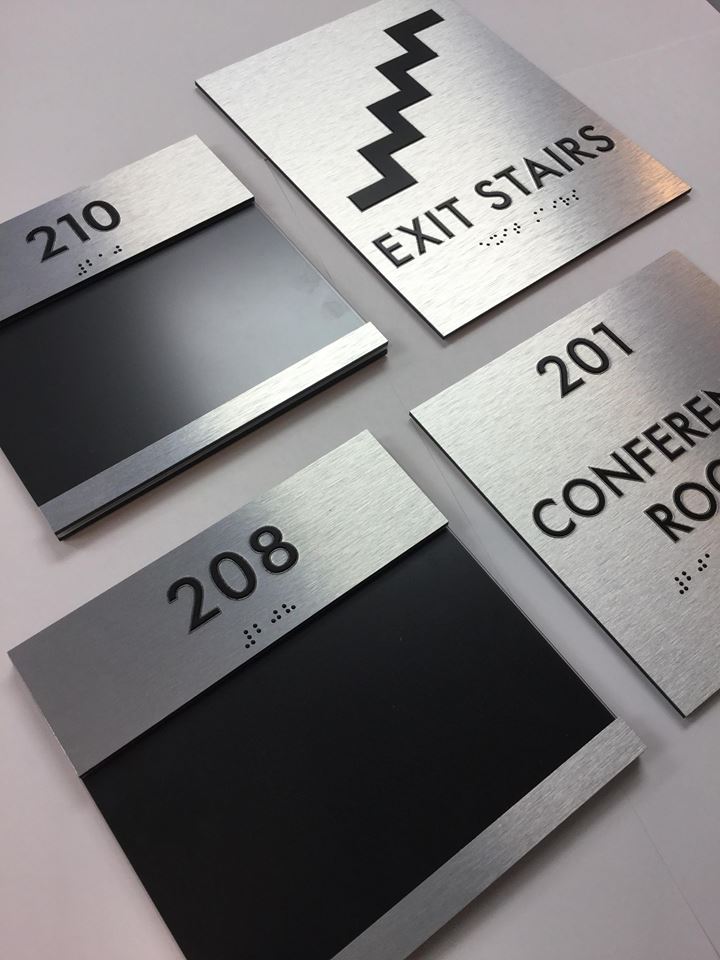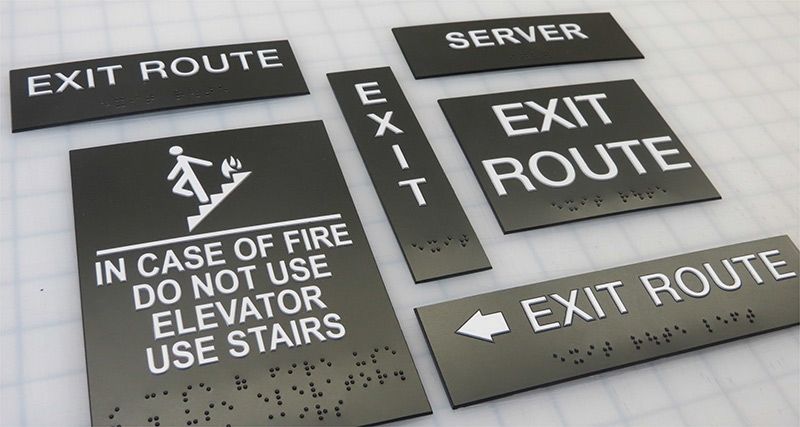ADA Signs: Necessary Tools for Inclusive Settings
ADA Signs: Necessary Tools for Inclusive Settings
Blog Article
Exploring the Secret Features of ADA Indicators for Enhanced Availability
In the world of accessibility, ADA indicators offer as silent yet effective allies, making sure that areas are inclusive and navigable for individuals with disabilities. By integrating Braille and tactile aspects, these signs break barriers for the aesthetically impaired, while high-contrast shade schemes and clear font styles provide to diverse visual demands.
Relevance of ADA Compliance
Guaranteeing conformity with the Americans with Disabilities Act (ADA) is important for fostering inclusivity and equal gain access to in public rooms and work environments. The ADA, enacted in 1990, mandates that all public facilities, companies, and transport solutions fit people with impairments, ensuring they delight in the exact same civil liberties and opportunities as others. Compliance with ADA standards not just meets lawful obligations however also boosts an organization's online reputation by demonstrating its dedication to diversity and inclusivity.
One of the key facets of ADA compliance is the application of available signage. ADA signs are made to make certain that individuals with handicaps can easily browse via structures and spaces.
Additionally, sticking to ADA laws can alleviate the danger of lawful repercussions and prospective fines. Organizations that fail to comply with ADA guidelines might deal with legal actions or penalties, which can be both financially challenging and destructive to their public image. Hence, ADA compliance is important to promoting an equitable atmosphere for everyone.
Braille and Tactile Components
The unification of Braille and tactile aspects right into ADA signs symbolizes the principles of availability and inclusivity. These attributes are vital for people who are blind or aesthetically impaired, enabling them to browse public areas with higher freedom and confidence. Braille, a responsive writing system, is important in offering created info in a format that can be easily perceived with touch. It is usually positioned beneath the matching text on signage to guarantee that people can access the info without aesthetic assistance.
Responsive aspects expand beyond Braille and consist of increased icons and characters. These components are designed to be noticeable by touch, enabling individuals to determine space numbers, bathrooms, departures, and other essential areas. The ADA establishes particular guidelines pertaining to the size, spacing, and placement of these tactile elements to enhance readability and make sure consistency throughout various atmospheres.

High-Contrast Color Pattern
High-contrast color systems play a pivotal function in enhancing the presence and readability of ADA signage for people with aesthetic problems. These systems are necessary as they make the most of the difference in light reflectance in between message and background, making sure that signs are easily discernible, also from a distance. The Americans with Disabilities Act (ADA) mandates making use of certain shade contrasts to suit those with minimal vision, making it a critical facet of compliance.
The effectiveness of high-contrast colors lies in their capability to stand out in various lights problems, including poorly lit settings and locations with glare. Typically, dark message on a light history or light text on a dark background is employed to accomplish optimum contrast. As an example, black text on a white or yellow background offers a stark aesthetic difference that helps in fast acknowledgment and understanding.

Legible Fonts and Text Dimension
When considering the design of ADA signs, the option of legible typefaces and appropriate message size can not be overemphasized. These aspects are important for ensuring that signs are available to individuals with aesthetic impairments. The Americans with Disabilities Act (ADA) mandates that font styles have to be sans-serif and not italic, oblique, script, highly ornamental, or of uncommon kind. These demands assist make certain that the text is easily understandable from a range and that the personalities are distinct to diverse audiences.
The size of the message additionally plays a critical function in accessibility. According to ADA standards, the minimal text elevation must be 5/8 inch, and it needs to boost proportionally with seeing range. This is specifically vital in public areas where signage demands to be read quickly and precisely. Uniformity in text dimension adds to a natural visual experience, aiding individuals in browsing atmospheres successfully.
In addition, spacing in between letters and lines is integral to readability. Appropriate spacing stops characters from showing up crowded, boosting readability. By sticking to these standards, designers can considerably boost ease of access, making sure that signs offers its desired purpose for all people, no matter of their aesthetic capacities.
Efficient Placement Strategies
Strategic positioning of ADA signage is vital for maximizing accessibility and making certain conformity with legal requirements. Correctly positioned indicators lead individuals with specials needs properly, facilitating navigation in public spaces. Key considerations include proximity, visibility, and elevation. ADA guidelines stipulate that indicators must be installed at a height in between 48 to 60 inches from the ground to guarantee they are within the line of view for both standing and seated people. This basic height variety is crucial for inclusivity, making it possible for mobility device users and people of varying heights to gain access to info easily.
Furthermore, indicators must be put adjacent to the lock side of doors to Learn More Here enable simple recognition before entry. Uniformity in sign positioning throughout a center improves predictability, decreasing complication and boosting overall Our site customer experience.
Verdict
ADA signs play a vital function in advertising accessibility by incorporating features that address the requirements of individuals with disabilities. These elements jointly promote a comprehensive environment, underscoring the value of ADA conformity in making certain equal gain access to for all.
In the world of availability, ADA indications offer as quiet yet powerful allies, ensuring that spaces are inclusive and accessible for people with disabilities. The ADA, passed in 1990, mandates that all public facilities, employers, and transport solutions suit people with handicaps, guaranteeing they delight in the exact same rights and chances as others. ADA Signs. ADA indications are designed to make certain that people with handicaps can quickly navigate via buildings and spaces. ADA standards stipulate that indicators ought to be placed at a height between 48 to 60 inches from the ground to guarantee they are within the line of sight for both standing and seated individuals.ADA signs play a vital duty in advertising accessibility by integrating functions that deal with the demands of individuals with disabilities
Report this page